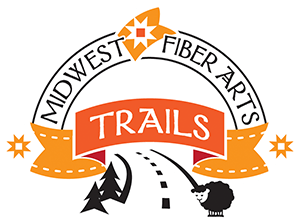How can it be that “not all felt is felted? That’s gotta be wrong.
Well it depends. It depends on how specifically or how loosely words are used. People use words in many ways to mean many different things. Sometimes, terms are important, sometimes they are not. Clear communication is more likely when people have a common framework and definition of the words used. In this case when felting means making felt from fiber to one person, and shrinking a knitted item in a washing machine to another person, a conversation can get pretty confusing. How I use the terms felting, fulling, felt, knit felt, woven felt, boiled wool, etc. evolve from the age old traditional method of wet felt making. To be able to concentrate on learning and enjoying the felt making process while using instructions, kits, and supplies; compatible comprehension of the terms the teacher or author uses may be crucial. The following is a brief definition of terms I use. These will be consistent with the way most traditional felt makers use them as well.
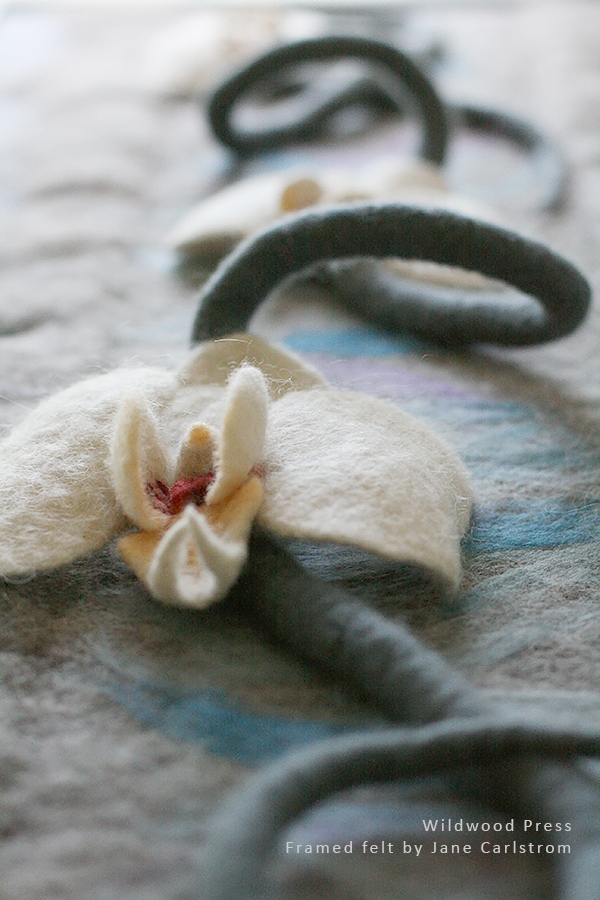
A wall hanging created in 2011. Incorporates all the types of felt I knew how to make at that time. Techniques included: wet felting, needle felting, laminate felting. Sewn onto a background of commercial wool felt and framed. (the background felt & wood frame not shown in this view)
Felting
The word felting is often used as a term to denote a complete process. In specific language “felting” is actually one step in a process of turning fiber into felt. The process may be called Felt making, traditional felting, wet felting. Felting, in the specific sense, is an almost magical way to get fibers to stick together and become fabric or soft sculpture. The scaly texture of the fibers/hair shafts allows them to mingle and tangle with other similar fibers and stick together. In felting, the hairs (fibers) tangle together until the snarl cannot be separated into single strands. Once matted together, the fibers can be shrunk, making them shorter and fatter and locking them firmly together.
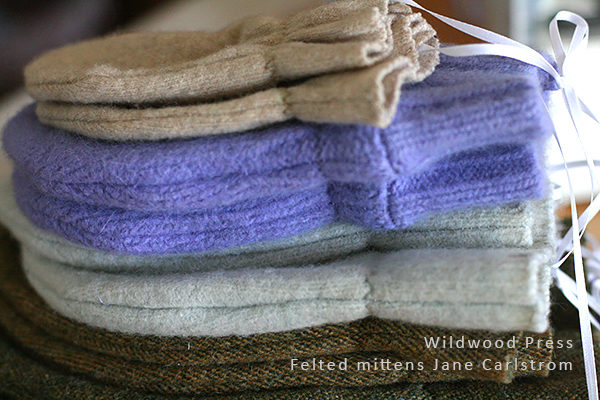
The top three are boiled wool mittens sewn from recycled lightly, fulled sweaters. The knit stitches are still visible. Mitten on the bottom is woolen fabric felt from an aggressively fulled recycled skirt.
Steps in Felt Making
1. Layout: Preparing fiber (roving or batt) for felting During layout, you will tease out tufts of fiber and lay them down in a pattern that allows the fibers to tangle together and form a matt.
2. Felting: Getting the fibers to hold together in a desired shape or design Felting involves using water and changing the pH (acidity) to open the fiber’s scales. Adding gentle friction (rubbing and/or rolling) to get the fibers to wiggle over and under each other makes the individual hairs work together so they hold together when pinched up.
3. Fulling: Making the fibers shrink into a firm felt using aggressive friction and shocking the fibers In the fulling stage, the fibers get shorter, fatter and pack together tightly. After fulling, the snarl of hairs is firmly set and cannot be torn apart. It can often be cut, and one can often sew through it, but one cannot untangle it.
4. Finished Felt: A non-woven, matted fabric that cannot be pulled apart and does not unravel Felt is made from hair fibers—usually unspun wool from sheep. Felt is, very simply, matted fiber that has been snarled and tangled and mashed down, and fulled (shrunk) so it sticks together. It cannot be pulled apart and does not unravel. Felt in this traditional methodology is made from fiber that has not gone through the spinning process.
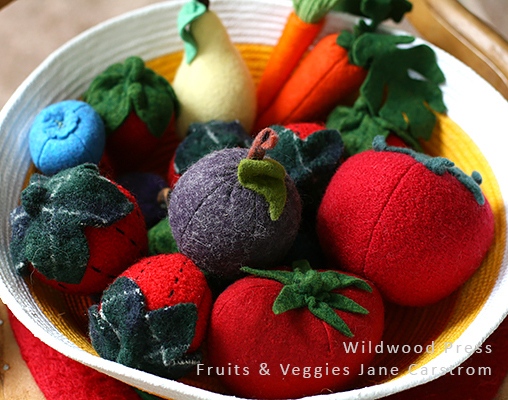
The two strawberries with black stitching are sewn from sweater felt. Boiled wool sweaters aggressively fulled and used as fabric. The other fruits and vegetables are sewn from fulled commercial wool felt. All are stuffed with wool batt.
The fiber used to make felt is in a pre-yarn stage called roving and batt. It becomes fabric or a 3-D object using this 4 step process. The confusion rages because some other fabrics can end up as “felt.” when felt is defined as a fabric that cannot be pulled apart and does not ravel. Fabric created from yarn by knitting, crocheting, or weaving, will hold together nicely and can be used as fabric without fulling. This fabric is commonly referred to as “knit” or “woven” based on the way the yarn is laced together. Knits can be unraveled or frayed. Woven fabrics can be frayed and can often be torn by hand. When lightly to moderately fulled, knit fabric becomes boiled wool. Boiled wool is a knit that has received some fulling, but is not dense enough to be called felt. One can still see individual knit stitch loops in boiled wool. After aggressive fulling (shrinking by boiling, washing by hand, or washing by machine), knits, wovens, and other laced/knitted fabrics become felt too—because the fabric will not fray or unravel and it cannot be pulled apart.
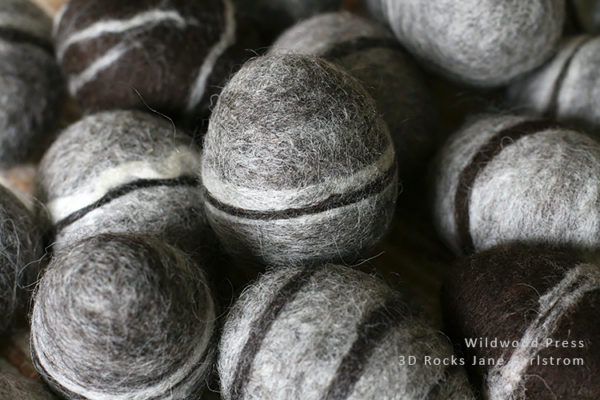
Needle felted from natural color wool roving, then fulled with soap and water. Combination of needle felting and wet felting.
Technical terms
Felt that starts out as…knitted fabric is “knit felt,” woven fabric is “woven felt, “ crocheted fabric is “crochet felt,” …and so forth for most other types of fabric created from wool yarn or thread. When recycling wool sweaters by fulling them, I call it “sweater felt.” It falls into the category of knit felt, but using the term sweater felt is a way to show that it was a sweater, no longer wearable, and has been recycled. When recycling
used, worn, woven woolen clothing by fulling, I call it “fulled woven fabric” if a cut edge will fray, and “woolen fabric felt” if it is so firmly fulled that a cut edge will not fray. Now you know just why I say “not all felt is felted.”
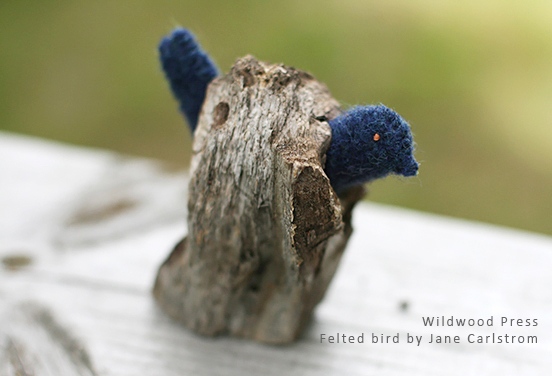
Woolen Fabric Felt sewn from fulled wool fabric, perched in found tree branch hole.
To conclude it goes like this:
If it begins as fiber, is snarled, matted and fulled until it does not ravel or tear it is felt that has been “felted.” If it starts as fiber, is spun or made into thread or yarn, knit, crochet, knotted, or woven, fulled until the stitch or weave cannot be seen, it does not ravel or tear, it is felt that has never been “felted.” All ways to make felt are good. There is no better, best, right or wrong. Most of the time, it does not matter too much. However when engaging in creating felt; or if you want to understand how something was created, use of precise language is useful. It then becomes paramount to understand the jargon; how the words are used and what they mean in various methods and techniques. Context, Context, Context. *Wondering about where needle felting fits in this? It is often a felt that has never been fulled. Therein lies another tale. As in some facebook relationship descriptions one can say “it’s complicated.”
For further exploration of felt making – felting terminology and word usage you might enjoy reading:
- The faqs pages of New England Felting Supply
- Feltmaking Terminology in North America by Pat Spark, © 1993 a pdf you can find and download here
- Another way to locate ways terms used in felt making is via the lead in information in most “how to make it” books or patterns. Many authors outline in either a preface or an opening chapter the framework of words, skill, techniques, definitions they operate within when practicing the art of felt making.
Jane Carlstrom is a retired Registered Nurse who is currently occupied with multiple roles of Felt Maker, Fiber Fiddler and Organic Farmer. She lives in the beautiful woods of northern Minnesota and is a member of the Pine to Prairie Fiber Arts Trail.
